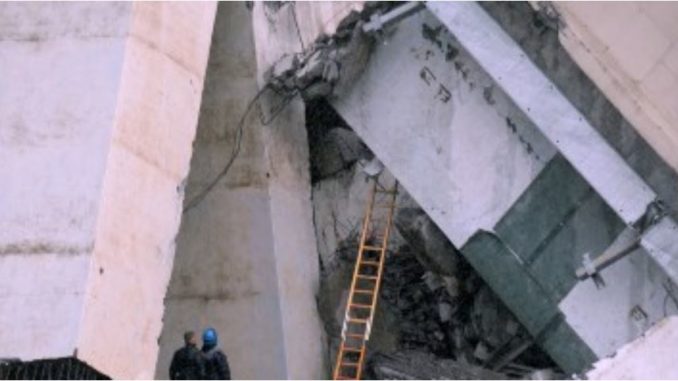
Tragedy struck in Italy last week when the Morandi Bridge in Genoa collapsed after a violent storm. The death toll has risen from initial 26 persons to 43 as of August 19, while hundreds were wounded. About 200 firefighters and other rescue officials have been on duty in search of people in the rubble, alive or dead. The ill-fated bridge of 1.8-kilometre length was built in 1967 and underwent maintenance two years ago.
A day after the disaster, the Italian Prime Minister, Giuseppe Conte, declared a 12-month state of emergency in Genoa, just as $5.7 million has been provided for the operation. Public indignation is mounting; and some of the bereaved refused to take part in the state funeral organised for the victims, as they preferred to bury their loved ones alone.
The Independent of London claims that experts have warned that as many as 300 bridges, viaducts and tunnels in Italy are at risk of structural failure. The newspaper says that the country’s civil engineering society – CNR – has called for a comprehensive plan to either repair or replace “tens of thousands” of bridges and viaducts built after the Second World War. Achieving this would gulp billions of dollars. Experts attribute the bridge collapse to corrosion of the technology used in its construction.
Conte’s government is as angry as the general public, which is why it plans to slam €150 million fines against Autostrade per I’Italian, the firm contracted to manage the bridge. Italy’s Minister of Transport, Danilo Toninelli, said, “This is a tragedy that is unacceptable in a modern society, and this government will do everything in its power to prevent anything of this kind from reoccurring.” The first step towards this is the planned revocation of the private firm’s contract.
Instructively, among those buried in the rubble were residents living under the bridge. It is also shocking that the safety of the bridge was reduced to a pun in the chessboard of that country’s politics. A report has it that in 2013, Beppe Grillo, the founder of Five Star – a political party – had opposed plans to build an alternative bridge to remove pressure from the collapsed infrastructure. He derided the warnings of its imminent collapse as a “fairy tale.”
With this calamity, concerns have been expressed about the integrity of similar infrastructure in Nigeria, against the backdrop of its notoriety for disregarding a viable maintenance culture and apparent political compromise of budgets for roads and similar infrastructure by the National Assembly. Therefore, the federal and state governments should immediately take stock of all bridges nationwide with a view to determining their integrity. The country has a road network of 193,200 kilometres with a motley assortment of long and short bridges, which are either not maintained at all, or are haphazardly done.
Perhaps, Italy’s tragedy brings in sharp relief the need for a Second Niger Bridge at Onitsha, Anambra State. The pressure on the old Niger Bridge and the cringes it frequently makes, have compelled the people of the South-East to urge the government to build a second bridge. Since 1999, every government has used this project to play a political dais with the people in getting their votes. But it serves all Nigerians. Unfortunately, the federal lawmakers reduced the budget for the project in the 2017 from N15 billion to N10 billion. The Lagos-Ibadan Expressway, which has a four-kilometre bridge at its Lagos end, also had N21 billion slashed from the N31 billion the Federal Government had provided. The same insensitivity has been exhibited in the 2018 budget. This means the legislators do not appreciate the economic value of the road, which the Federal Road Safety Commission says 25,000 vehicles from every part of Nigeria ply every hour.
After prevaricating, federal authorities would shut the Third Mainland Bridge, Lagos, from August 23rd to 26th to enable contractors assess its integrity, ahead of maintenance work that would start towards the end of this year or early next year. The 11 kilometre, bridge, said to be the longest in Africa, is poorly maintained, evident in its macadamised surface. Just as the Niger Bridge, users of the bridge cry loudly of the vibration it emits, being a victim of suffocating gridlock on a regular basis. Shortly after a 2012 maintenance work on the bridge, the senator representing the area, Gbenga Ashafa, in a motion of urgent national importance in the Senate, alleged that the maintenance carried out was inadequate. He said, “The experts went back after those remedial measures were taken and came back with the report that something has to be done urgently.”
Many things compromise the integrity of bridges. They include sand dunes and waste from road users that blocked holes meant for rain water to flow out; and under every bridge make-shift stalls, mechanic workshops, block and brick moulders, mosques and parking space for heavy duty vehicles, tippers and gravel dealers form a dangerous mix that produces corrosive effects on the bridge pillars. But smaller bridges have been caving in after a spell of heavy rainfall, like the Mokwa–Jebba Bridge in January 2017; the Dilichim Bridge that cut off communities in Michika and Madagali Local Government Area in Adamawa State.
However, no state is more prone to this looming disaster than Lagos State, whose labyrinth of bridges and flyovers have dead weights or articulated vehicles on them, at Ojuelegba, Carter, Apapa and Ijora. The recalcitrant drivers of these vehicles park on them as long as two weeks. The authorities in Lagos and Abuja should not wait for this obvious disaster waiting to happen to materialise before the ultimate action is taken.
END

Be the first to comment